
Hypsilophodon is a neornithischian dinosaur genus from the Early Cretaceous period of England. It has traditionally been considered an early member of the group Ornithopoda, but recent research has put this into question.
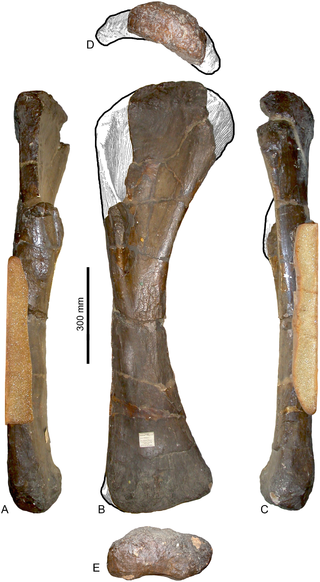
Pelorosaurus is a genus of titanosauriform sauropod dinosaur. Remains referred to Pelorosaurus date from the Early Cretaceous period, about 140-125 million years ago, and have been found in England and Portugal. Thomas Holtz estimated its length at 24 meters.

Yaverlandia is a genus of maniraptoran dinosaur. Known from a partial fossil skull found in Lower Cretaceous strata of the Wessex Formation on the Isle of Wight. it was described as the earliest known member of the pachycephalosaurid family, but research by Darren Naish shows it to have actually been a theropod, seemingly a maniraptoran. The type species is Y. bitholus.
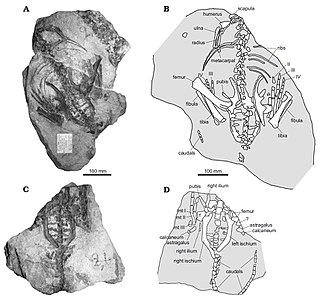
Stenopelix is a genus of small marginocephalian dinosaur, possibly a basal ceratopsian, from the Early Cretaceous of Germany. It lived in the late Berriasian Stage of the Cretaceous period, approximately 140 myr ago. The genus is based on a partial skeleton lacking the skull, and its classification is based on characteristics of the hips.
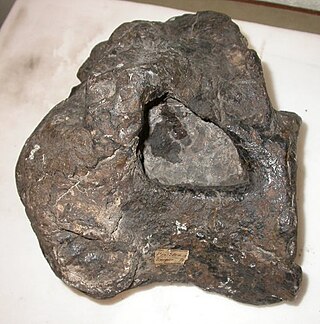
Ornithopsis was a medium-sized Early Cretaceous sauropod dinosaur, from England. The type species, which is the only species seen as valid today, is O. hulkei.
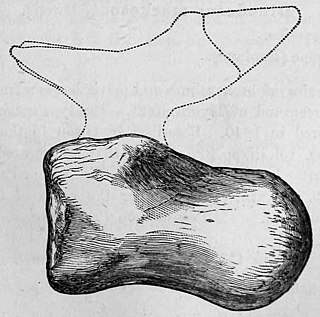
Iuticosaurus is a genus of titanosaur sauropod dinosaur from the Early Cretaceous of the Isle of Wight. Two species have been named: I. valdensis and I. lydekkeri. I. valdensis was found in the Wessex Formation and I. lydekkeri in the younger Upper Greensand.

Allodaposuchus is an extinct genus of crocodyliforms that lived in what is now southern Europe during the Campanian and Maastrichtian stages of the Late Cretaceous. Although generally classified as a non-crocodylian eusuchian crocodylomorph, it is sometimes placed as one of the earliest true crocodylians. Allodaposuchus is one of the most common Late Cretaceous crocodylomorphs from Europe, with fossils known from Romania, Spain, and France.
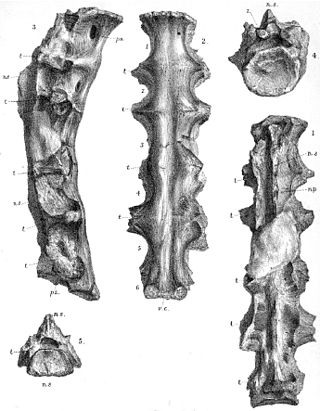
Ornithodesmus is a genus of small, dromaeosaurid dinosaur from the Isle of Wight in England, dating to about 125 million years ago. The name was originally assigned to a bird-like sacrum, initially believed to come from a bird and subsequently identified as a pterosaur. More complete pterosaur remains were later assigned to Ornithodesmus, until recently a detailed analysis determined that the original specimen in fact came from a small theropod, specifically a dromaeosaur. All pterosaurian material previously assigned to this genus has been renamed Istiodactylus.
Pachycheilosuchus is an extinct genus of neosuchian from the Early Cretaceous of Texas, United States. Previously known, in part, as the "Glen Rose form", this crocodylomorph is notable for its procoelous vertebrae, otherwise found only in derived eusuchian crocodilians, a thick margin on the maxillae, and a shield of armor on the neck formed by the fusion of six individual scutes.

Sichuanosuchus is an extinct genus of crocodylomorph from the Late Jurassic and possibly Early Cretaceous of China.
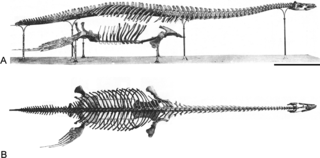
Brancasaurus is a genus of plesiosaur which lived in a freshwater lake in the Early Cretaceous of what is now North Rhine-Westphalia, Germany. With a long neck possessing vertebrae bearing distinctively-shaped "shark fin"-shaped neural spines, and a relatively small and pointed head, Brancasaurus is superficially similar to Elasmosaurus, albeit smaller in size at 3.26 metres (10.7 ft) in length as a subadult.

Eusuchia is a clade of neosuchian crocodylomorphs that first appeared in the Early Cretaceous, which includes modern crocodilians. Along with Dyrosauridae and Sebecosuchia, they were the only crocodyliformes who survived the K-T extinction.
The Vectis Formation is a geological formation on the Isle of Wight and Swanage, England whose strata were formed in the lowermost Aptian, approximately 125 million years ago. The environment of deposition was that of a freshwater coastal lagoon with occasional marine influence after the early Aptian marine transgression, transitioning from the floodplain environment of the underlying Wessex Formation. The primary lithology is of laminated grey mudstones. The Vectis Formation is composed of three geological members: the Shepherds Chine member, the Barnes High Sandstone member, and the Cowleaze Chine member. It is overlain by the fully marine Atherfield Clay Formation, part of the Lower Greensand Group. Dinosaur remains are among the fossils that have been recovered from the formation.

Acynodon is an extinct genus of eusuchian crocodylomorph from the Late Cretaceous, with fossils found throughout Southern Europe.
Hylaeochampsa is an extinct genus of eusuchian crocodylomorphs. It is known only from a partial skull recovered from Barremian-age rocks of the Lower Cretaceous Vectis Formation of the Isle of Wight. This skull, BMNH R 177, is short and wide, with a eusuchian-like palate and inferred enlarged posterior teeth that would have been suitable for crushing. Hylaochampsa was described by Richard Owen in 1874, with H. vectiana as the type species. It may be the same genus as the slightly older Heterosuchus, inferred to have been of similar evolutionary grade, but there is no overlapping material as Heterosuchus is known only from vertebrae. If the two could be shown to be synonyms, Hylaeochampsa would have priority because it is the older name. Hylaeochampsa is the type genus of the family Hylaeochampsidae, which also includes Iharkutosuchus from the Late Cretaceous of Hungary. James Clark and Mark Norell positioned it as the sister group to Crocodylia. Hylaeochampsa is currently the oldest known unambiguous eusuchian.
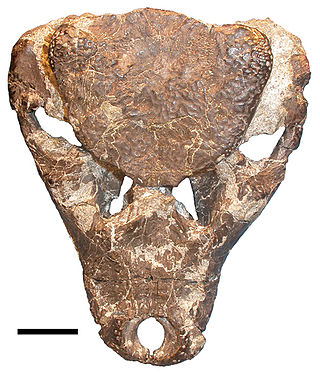
Hylaeochampsidae is an extinct family of basal eusuchian crocodylomorphs thought to be closely related to the order Crocodylia.
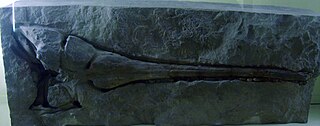
Pholidosaurus is an extinct genus of neosuchian crocodylomorph. It is the type genus of the family Pholidosauridae. Fossils have been found in northwestern Germany. The genus is known to have existed during the Berriasian-Albian stages of the Early Cretaceous. Fossil material found from the Annero and Jydegård Formations in Skåne, Sweden and on the island of Bornholm, Denmark, have been referred to as a mesoeucrocodylian, and possibly represent the genus Pholidosaurus.
Shantungosuchus is an extinct genus of Early Cretaceous crocodyliform found in China. It includes three species: Shantungosuchus chuhsienensis and S. brachycephalus, which were both described by Yang Zhongjian – usually referred to as "Young" – in 1961 and 1982, and S. hangjinensis, which was described by Xiao-Chun Wu et al in 1994. S. chuhsienensis is the type for this genus.
Anteophthalmosuchus is an extinct genus of goniopholidid mesoeucrocodylian from the Early Cretaceous of southern England, eastern Spain, and western Belgium.

Agaresuchus is an extinct genus of allodaposuchid eusuchian crocodylomorph from the Late Cretaceous (Campanian-Maastrichtian) of Spain. It includes two species, the type species Agaresuchus fontisensis, and Agaresuchus subjuniperus, which was originally named as a species of the related genus Allodaposuchus. However, it has been proposed that both species may instead belong to the genus Allodaposuchus.

















